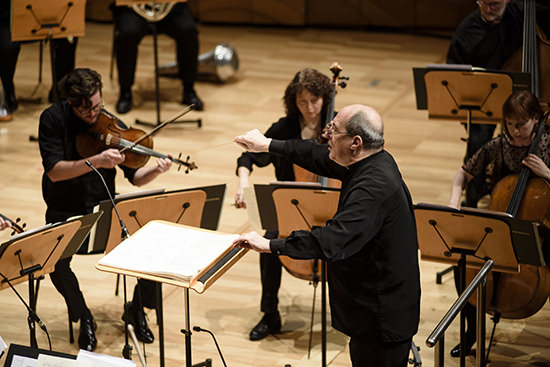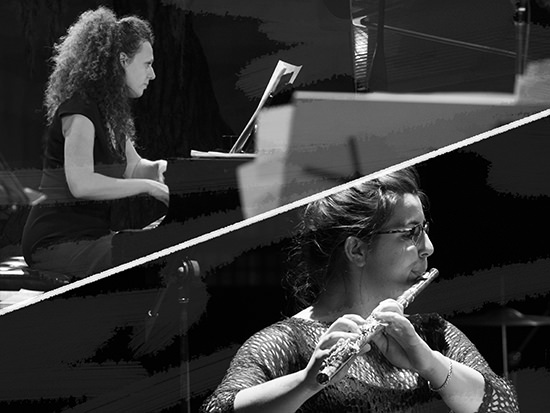The city as problem and solution
Matthew Lorenzon: Metropolis New Music Festival, Music of the City

Robert Spano conducts Melbourne Symphony Orchestra, Metropolis New Music Festival
photo Daniel Aulsebrook
Robert Spano conducts Melbourne Symphony Orchestra, Metropolis New Music Festival
The 2016 Metropolis New Music Festival explored the city’s problems and to a lesser extent their solutions. For the first time in the world’s history over half of the world’s population lives in cities. If ancient settlements arose to solve problems such as the need for safety and trade, cities now pose their own problems to which we must adapt as a species. Addressing these problems is not only the realm of civic planners and concerned citizens. The musicians of Homo Urbanus also face the economic, environmental and sexual situations of the modern city.
With a larger local population comes anonymity and the sexual deviance that anonymity affords. Or at least this was the old Subcultural Studies line. While there is no denying the continued conservatism of some quarters, the late capitalist city resembles more of an open marketplace of sexual desires than a Victorian den of iniquity. This was the take-away message of the bold opening to Forest Collective’s Sensuality in the City program. “I wanna fuck Chris Hemsworth,” proclaimed Christian Gillett in the darkened Melbourne Recital Centre salon, “I wanna fuck Chris Hemsworth forever.” Philip Venables’ F**k Forever suggests there is nothing closeted about sexuality in the contemporary city.
The Melbourne Symphony Orchestra’s guest conductor Robert Spano painted the city on a grand scale in three concerts. How could a music festival dedicated to the city not include works like Michael Daugherty’s Sunset Strip, Steve Reich’s City Life, Jennifer Higdon’s City Scape or Aaron Copland’s Music for a Great City? Each of these pieces depicts a city bustling with construction and economic activity. They are clearly pieces of the late 20th century, composed during a period of unprecedented economic growth and general obliviousness to the environmental effects of greenhouse gases. They present the city as a place of opportunity tempered only by the social inequalities that arise in free markets.
These works also address social stratification by evoking local places, quoting popular music and incorporating speech patterns recorded on the street. In doing this they participate in a centuries-old tradition. The Song Company highlighted this historical continuity with a series of “street cry” pieces from the Renaissance to the 20th century as part of the MSO’s City Scapes program. The company’s superb performance of Luciano Berio’s Cries of London, including the refrain “These are the cries of London town, some go up street some go down,” brought the economic subtext of these pieces to the foreground.
Street-level details were also found in stunning orchestral works by Unsuk Chin and Michael Kurth. Chin’s supposedly non-programmatic (though to my ears extremely evocative) Graffiti begins with ‘scratching’ strings like the furtive carvings on the walls of ancient cities. The audience is then taken through an eerie “Notturno Urbano” and an uproarious “Urban Passacaglia.” Graffiti was an epiphany. We don’t get enough opportunities in Australia to cheer Chin’s work performed live. The composer Michael Kurth also takes the streets as his inspiration in Everything Lasts Forever, which includes three movements inspired by Atlanta street art. The cartoon feet of the street artist Toes are represented by swaggering slap bass. The pathos of a bird singing on a boarded-up door is conjured in a sadly lyrical movement. A loping movement in an additive meter presents an ironic commentary on the message “We Have All the Time in the World.”
If 20th-century composers saw the city as a place of opportunity and social inequality, two pieces presented as part of the Cybec 21st Century Australian Composers Program paint the city as an existential threat. Alex Turley’s finely atmospheric City of Ghosts considers a city without people. Modal melodies arise from a subtly thunderous bed of pianissimo tuba and double bass. The melodies move wraith-like across the ensemble, describing towering buildings and arches. With its profound palette, City of Ghosts is testament to Turley’s musical imagination and honed talents as an orchestrator. Chillingly, the piece presents us with a world without humans, leaving us guessing at where all the people have gone.
Michael Bakrncev’s Sky Jammer considers urban problems of the future. Will the environment be able to support Melbourne’s projected population of 10 million by 2050? What about the social ramifications of urban expansion fuelled by property speculation? With median house prices at or near one million dollars in Melbourne and Sydney, young people can’t afford to buy property near their families or where they grew up. Tax breaks intended to increase the supply of housing fuel intergenerational inequality instead.
Complex subject matter requires a complex sound world and Sky Jammer so clearly draws on Bakrncev’s musical influences. In its dense, rapidly changing textures one can hear the influence of Australian complexist composers. The instrumental timbres have the grit of a piece by Anthony Pateras. With its attention to instrumental colour and formal cohesion one can hear the influence of Bakrncev’s teacher Elliott Gyger. Though this description might make him sound like the love-child of dour modernists, Bakrncev brings his own crowd-pleasing style to the piece, in particular during a virtuosic violin solo for Sophie Rowell, who needs to be congratulated for several incredible solo passages throughout the festival.

Lina Andonovska (flute), Sonya Lifschitz (piano), Crashing Through Fences, Press, Play program
photos courtesy Metropolis New Music Festival
Lina Andonovska (flute), Sonya Lifschitz (piano), Crashing Through Fences, Press, Play program
Sure, they may be totemic tributes to property speculation, but I am not so down on Melbourne’s skyscrapers as Bakrncev. As Le Corbusier told us in Robert Davidson’s City Portraits (as part of Press, Play’s program), in order for everyone to have access to “sun, space, and green,” 2000 people must live in a building connected by a “vertical road.” Sure, many of Le Corbusier’s brutalist apartment blocks were barely habitable, but when his words are set to Davidson’s bitter-sweet piano part and performed by Sonya Lifschitz I am almost ready to believe again. More importantly, enlightened high-density development in the spirit of Le Corbusier will be necessary if 10 million people are to minimise their impact on the environment. The bustling, free-market, “Cries of London” urban model is not sustainable. Through varied and thought-provoking programs Metropolis starkly captured the liminal time in which we live.
–
See Partial Durations for reviews of more Metropolis concerts including those by Michael Kieran Harvey, Syzygy Ensemble and Elision.
RealTime issue #133 June-July 2016






